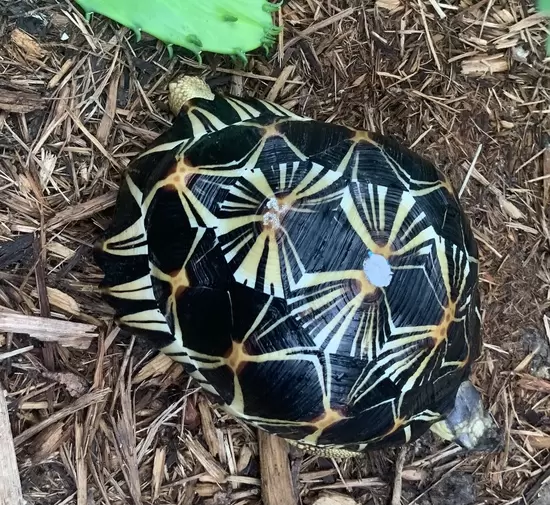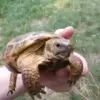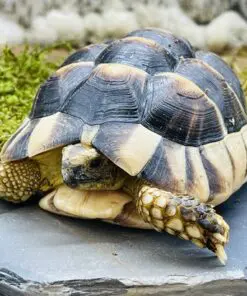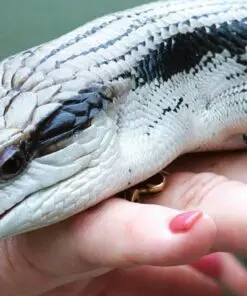Radiated Tortoise
$2,000.00 Original price was: $2,000.00.$1,700.00Current price is: $1,700.00.
4 in stock
Radiated Tortoise
The radiated tortoise has the basic tortoise body shape, which consists of the high-domed shell, a blunt head and elephantine feet. The legs, feet and head are yellow except for a variably sized black patch on top of the head.
The carapace of the radiated tortoise is brilliantly marked with yellow lines radiating from the center of each dark plate of the shell, hence the name radiated tortoise. This star pattern is more finely detailed and intricate than the normal pattern of other star-patterned tortoise species, such as the Indian star tortoise. The radiated tortoise is also larger than the Indian star tortoise and the scutes of the carapace are smooth and not raised up into a bumpy, pyramidal shape, as is commonly seen in the latter species.
Radiated Tortoise
Compared to females, male radiated tortoises usually have longer tails and the notch in the plastron beneath the tail is more noticeable. Unlike the yellow coloration of the adults, the juveniles are a white to an off-white shade. The shell is supplied with blood vessels and nerves so like other tortoises, it can feel when being touched.
Size
Radiated tortoises grow to a shell length of up to 16 inches (41 centimeters) and weighing up to 35 pounds (16 kilograms)
Native Habitat
Radiated tortoises only occur naturally in the extreme southern and southwestern part of the island of Madagascar. They have been introduced to the nearby island of Reunion. Radiated tortoises prefer dry regions of brush, thorn forests and woodlands of southern Madagascar.
Food/Eating Habits
The radiated tortoise is an herbivore. Grazing makes up approximately 80 to 90 percent of their diet. They feed during the day primarily on grasses, fruit and succulent plants. A favorite food in the wild is the Opuntia cactus.
They are known to graze regularly in the same area, thus keeping the vegetation in that area closely trimmed. They seem to prefer new growth rather than mature growth because of the high protein and low fiber content.
At the Smithsonian’s National Zoo, they are fed a mixture of leafy greens, mushrooms and turtle pellets.
Reproduction and Development
Males first mate upon attaining lengths of about 12 inches (31 centimeters); females may need to be a few inches longer. The male begins this noisy procedure by bobbing his head and smelling the female’s hind legs and cloaca. In some cases, the male may lift the female up with the front edge of his shell to keep her from moving away. The male will then proceed to mount the female from the rear while striking the anal region of his plastron against the female’s carapace. Hissing and grunting by the male during mating is common.
Females lay from three to 12 eggs in a pre-excavated hole 6 to 8 inches (15 to 20 centimeters) deep and then depart. Incubation is quite long in this species, lasting usually between five and eight months. Juveniles are between 1.25 to 1.6 inches (3.2 to 4 centimeters) upon hatching. They attain the high-domed carapace soon after hatching.
Sleep Habits
Radiated tortoises are active during the day.
Lifespan
Radiated tortoises can live for 40 to 50 years
Be the first to review “Radiated Tortoise” Cancel reply
Related products
tortis
tortis
tortis
tortis
tortis
tortis
tortis













Reviews
There are no reviews yet.